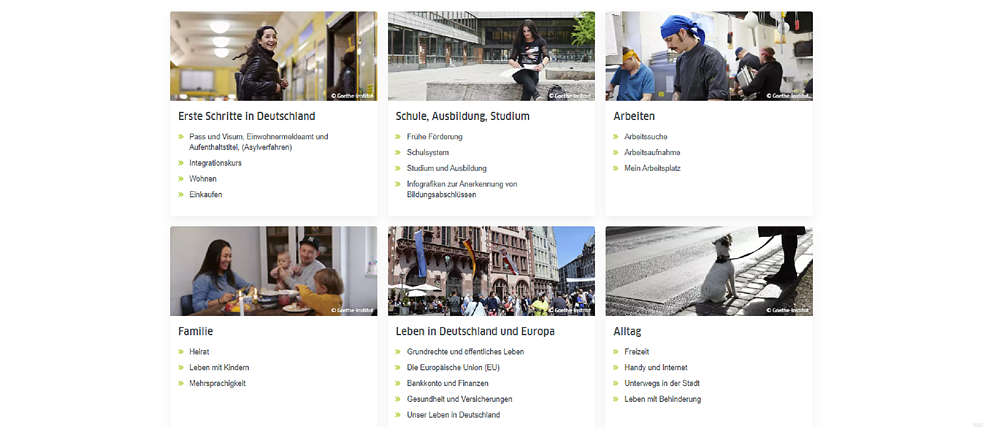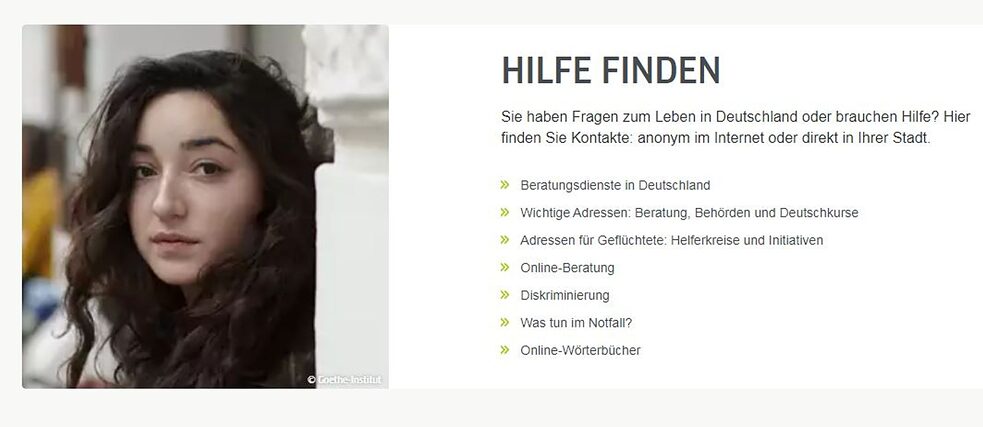"My Way to Germany" web portal
Four Tips on teaching German to skilled workers from abroad

The Goethe-Institut's "My Way to Germany" web portal provides German language exercises as well as useful information about living and working in Germany. We show four ways in which teachers of German as a foreign language can use the collection of materials for their teaching and independent learning.
By Julia Wecker
HELPING NEWCOMERS TO GERMANY GET THEIR BEARINGS
Moving to a new country involves a great many challenges and questions. The "My Way to Germany" web portal provides some basic orientation aids in about 30 languages for skilled workers from abroad who are planning to move to Germany or have only been living and working in Germany for a short time. The portal uses a self-learning approach in the following three sections: "Living in Germany", "Practise German" and "Getting Help". German teachers giving courses to skilled workers from abroad should also be able to find what they’re looking for on the portal: its multi-faceted contents will prove an invaluable source for your own research as well as for use in German courses.TIP 1: TEACHING MATERIAL
To introduce teachers and counsellors to the portal and its various uses, the "For Teachers" section provides an overview of all the language-learning services and materials available on the portal as well as links to other useful sites and ideas for using the web portal for teaching purposes.The materials available on the portal also include a brochure called "Mein Deutschlandheft" (My Germany booklet), which is designed to facilitate access for each individual learner to their future everyday life in Germany from the beginning. Corresponding didactic suggestions are provided with a number of worksheets for use in class. The types of tasks to be completed are based on the task types typically used on Goethe-Institut examinations, so these tasks, in addition to intercultural sensitization exercises for various situations in everyday life, can be incorporated into exam prep work.
TIP 2: EASY TEXTS FOR BEGINNERS ABOUT LIVING IN GERMANY
 Everyday topics presented in basic German | © Goethe-Institut
The "Living in Germany" section provides information about everyday life and working life, educational and training systems, leisure activities and the public sphere in Germany and Europe. The German texts here are for A1–A2 levels and can be heard using the audio player. Difficult vocabulary is explained separately in the glossary, and helpful links are provided for more information about each topic.
Everyday topics presented in basic German | © Goethe-Institut
The "Living in Germany" section provides information about everyday life and working life, educational and training systems, leisure activities and the public sphere in Germany and Europe. The German texts here are for A1–A2 levels and can be heard using the audio player. Difficult vocabulary is explained separately in the glossary, and helpful links are provided for more information about each topic.The learners follow a character named Nevin through various situations involved in coping with new surroundings. Here’s a simple suggestion for a reading comprehension exercise in class: on the subject of "work", the teacher clicks on the text "My Workplace" and hands out one of the corresponding worksheets (see master copy, page 23). The learners read the text and do the exercise. The whole class then checks their answers together.
TIP 3: "information Search” FEATURE TO FOSTER project work and INDEPENDENT learning
 Interactive features for self-learning | © Goethe-Institut
The "Practise German" section contains lots of exercises about typical everyday situations for language levels A1 to B2. They are also suitable for use in blended learning and virtual classes.
Interactive features for self-learning | © Goethe-Institut
The "Practise German" section contains lots of exercises about typical everyday situations for language levels A1 to B2. They are also suitable for use in blended learning and virtual classes.In the "Information Search" section, learners are guided through various types of exercises and can put together a portfolio in which to find useful information at a glance. It’s a good idea to present this portfolio in class to help learners access and use this tool.
Our suggestion: The teacher shows the search page on the subject of shopping, which the learners can then work on independently on their own computers. They will automatically receive feedback on their answers to the closed-ended questions as they go. The teacher then presents the portfolio task at the end of each topic and explains that they can find information there for their own purposes in Germany. The learners can have their own notes e-mailed to them.
TIP 4: AUTHENTIC SEARCH TASKS USING THE “GET HELP” SECTION
 Find the right contacts quickly | © Goethe-Institut
The "Get Help" section for levels A1 to B1 provides information and concrete pointers regarding useful counselling centres for newcomers to Germany. The Goethe-Institut cooperates here with Germany’s Youth Migration Services (JMD) and refers labour migrants to the JMD’s online counselling services in this section of the portal.
Find the right contacts quickly | © Goethe-Institut
The "Get Help" section for levels A1 to B1 provides information and concrete pointers regarding useful counselling centres for newcomers to Germany. The Goethe-Institut cooperates here with Germany’s Youth Migration Services (JMD) and refers labour migrants to the JMD’s online counselling services in this section of the portal.For the use of this feature in class, we have a suggestion for advanced learners:
The teacher selects some contacts that could be useful for course participants (e.g. Migration Advice for Adult Immigrants (MBE), Youth Migration Services (JMD), immigration offices and integration course providers) and, after dividing the participants up into groups, has them look through the "Migration Advice Services in Germany" section to find out what functions these institutions perform in Germany and what sorts of inquiries should be addressed to each of them. In "Important Addresses", they can use the search mask to look for useful contacts at their future places of residence. This exercise can be done in the classroom if a sufficient number of computers or tablets are available there, or online, of course. It can also be done in groups and varied as desired.
We hope you and your participants will enjoy working with "My Way to Germany" and find it useful and effective!
